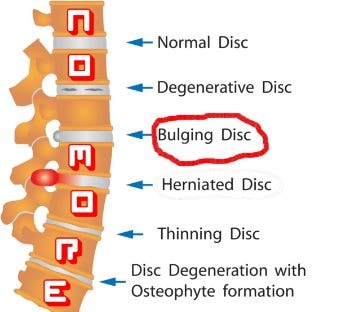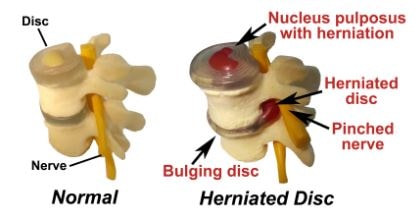Bulging Disc
There are different injuries that can be sustained in the spinal column. These conditions can occur in any area of the spine and can cause signs and symptoms depending on which area is affected. One of the most common spinal problems is bulging disc and it can cause pain to different parts of the body [1, 2].
What is Bulging Disc?
Spinal discs are found in between the vertebra of the spinal column. These discs acts as shock absorbers and allow the movement at each level of the spine. Their placement allow enough room for the spinal nerves to exit the spine towards the area that they innervate. These discs have 2 distinct parts: the outer section called Annulus Fibrosus is composed of multiple layers of multi-directional fibrocartilage and it center, also called Nucleus Pulposus, is made up of glycoprotein.

Figure 1 shows the structure of a spinal disc [1, 2, 3].
A bulging disc is the condition in which the annulus weakens and the nucleus presses outwards. When the said bulging compress any spinal nerve, it will cause the presenting symptoms. Many of the individuals who have this condition do not experience any symptom because the bulge does not press on any structure. Around 90 percent of all the cases of bulging discs occur in the lumbar area and the symptoms are similar to that of a sciatic nerve damage [1, 2, 3].

ICD10
For a bulging disc disorder, the 2016 ICD-10-CM diagnosis code that can be used is M51.9 [4].
Causes
There are 3 major causes of bulging disc [1, 3]:
Degenerative Disorder
Degenerative disorders, such as osteoarthritis, that usually come with aging may reduce the density of the spinal disc wall. The weakening of annulus fibrosus increases the risk of the nucleus pulposus outward [1, 3].
Microtrauma
Microtrauma that had accumulated through the years may eventually lead to bulging of the disc. There are several examples of microtrauma and one of which is having a poor posture. Slouching can lead to overstretching and weakness of the annulus of the spinal discs. Repeated slouching can cause poor integrity of the disc and may displace the nucleus towards the back of the spine [1, 3].
Sudden Trauma
Traumatic situations such as motor vehicular accidents may result in damage to the annulus. The damage is due to the bodies attempt to repel the sudden impact from the accident [1, 3].
Signs and Symptoms
The most common symptom of bulging disc is back pain. This type of back pain is worsen by bending forward, sitting, lifting, and when coughing or sneezing. A bulging disc is considered to be worsening if there is leg pain, tingling, weakness and numbness. Severe cases may cause alterations in bladder and bowel functions [1, 2, 3].
Diagnosis
Health History and Physical Examination
The medical history will focus on the symptoms that are experienced by the patient. Any previous traumatic incidents shall be known as this may have cause or contributed to the bulging of the discs. The physician will perform a physical examination to verify the signs of a possible nerve compression [1, 2, 3].
Imaging Tests
The diagnosis of a bulging disc will be verified through a bulging disc. An x-ray may not be able to show the bulging disc but it will show a visualization of the degeneration of the spine. A Magnetic Resonance Imaging (MRI) scan is considered to be the best way to confirm the diagnosis [1, 2, 5].
Electromyelogram
Electrical tests, such as an electromyelogram, can be performed to verify if the leg pain is coming from a damaged nerve. This test can also show the degree of damage to the compressed nerve [1, 2, 5].
Treatment
Conservative Treatment
The first goal in the treatment of bulging disc is the relief of symptoms. Nonsteroidal anti-inflammatory drugs are the medication of choice to relieve the pain and pressure. The bulging disc will need time to heal and the physiotherapist will advise the best positions to maintain the nucleus in the center of the spinal disc. By following these positions, the fibrocartilage that had torn will be kept close to each other and the structure of the annulus will be maintained as close to normal as possible [1, 2, 6].
Surgical Treatment
If the conservative treatment modality is unsuccessful, the physician may recommend a surgical procedure. A microdiscectomy may be performed to remove the herniated portion of the spine. If the degeneration of the spine is truly advanced, a spinal fusion may be done instead. This procedure will fuse the disc spaces together to preserve the integrity of the spine [1, 2, 6].
Exercises
The goal of the exercises during the rehabilitation phase is to prevent the recurrence of back pain. Deep abdominal and core muscle exercises will be able to maintain the strength of the back. Any defects after the surgery will be corrected by the physiotherapist. It is essential to follow through with the rehabilitation to be successful in achieving its goal [1, 2, 6].
References
- Miller, J. (2015, September 15). Bulging Disc. Retrieved from Physio Works: http://physioworks.com.au/injuries-conditions-1/bulging_disc
- Perry, M. (2015). Bulging Disc. Retrieved from Laser Spine Institute: https://www.laserspineinstitute.com/back_problems/bulging_disc/
- Morris, S. Y. (2015, February 23). Bulging Disks: About That Pain in Your Neck. Retrieved from Healthline: http://www.healthline.com/health/neck-pain/bulging-disks#1
- ICD10 Data. (2015). 2016 ICD-10-CM Diagnosis Code M51.9. Retrieved from ICD10 Data: http://www.icd10data.com/ICD10CM/Codes/M00-M99/M50-M54/M51-/M51.9
- University of Maryland Medical Center. (2003). Lumbar Herniated DIsc. Retrieved from University of Maryland Medical Center: http://umm.edu/programs/spine/health/guides/lumbar-herniated-disc
- Perez, D. (2015, September 23). How to Treat a Bulging Disc in Your Lower Back. Retrieved from Patch: http://patch.com/california/sanramon/bp–how-to-treat-a-bulging-disc-in-your-lower-back
